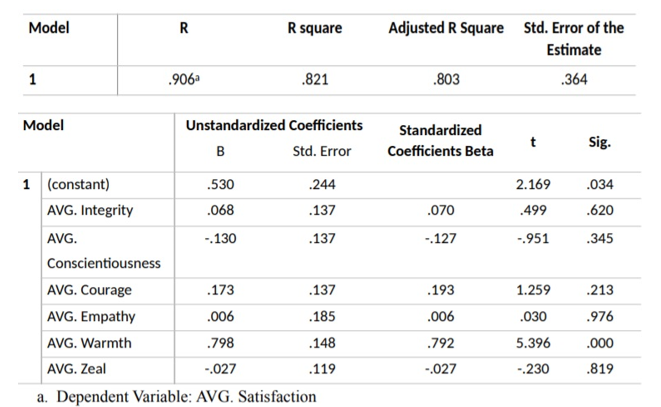Introduction
Organizational virtue is a crucial asset clarifying a vast disparity in satisfaction, identification, and distinctiveness from the context of the two most pivotal stakeholder groups, namely customers and employees. The study investigates the critical aspects of organizational virtue and their impact on employee satisfaction in UAE enterprises. The main elements of the increased employee satisfaction encompass “empathy, integrity, contentiousness, warmth, courage, and zeal” (Alkaabi et al., 2020–2021). Research methodology implies a quantitative analysis based on a survey conducted among UAE companies’ employees and processed responses by using IBM SPSS Statistics software. This presentation will discuss the Analysis section of the study, including all the statistical data regarding respondents’ attitudes towards organizational virtue.
Profile of Respondents
The respondent profile formed from the data collected was analyzed according to the variables, items, frequency, and percentage. Altogether, the study involved 69 participants of different nationality, age, gender, industrial sector, rank, years of service, number of employees, and ownership. Apart from 62 respondents from the UAE, the research included two Jordanians, three Filipinos, one Indian, and one Palestinian. They were segregated into three age categories.
The respondents were employed in various organizations carrying out different types of activities with different lengths of service. Additionally, the profile involved the size of the entrepreneurship where the employees work. As such, the gathered data provided a broad spectrum of information to consider the high degree of representation of the UAE workforce.
Descriptive Statistics
Descriptive statistics of the study are based on a five-point Likert scale to describe independent variables. It was a crucial tool that helped collect important data to illustrate the participants’ attitude towards the assessment of “integrity, empathy, warmth, conscientiousness, zeal, courage, and satisfaction” (Alkaabi et al., 2020–2021, p. 18). The employee’s perceptions were examined in the context of their unique insights and their organizations. Descriptive statistics aimed to summarize the data received. The main parameters of the framework implied mean, standard deviation, and variance.
Based on the recorded data, the respondents mainly provided positive answers for all the statements out of 56. This, therefore, signifies agreement or strong agreement with the given statements. The minimum reported mean was 3.32, while the maximum mean was 3.96. In general terms, the majority of employees defined their companies as oriented toward organizational virtue. The standard deviation: minimum value was 0.809 and the maximum was 1.123.
The most significant deviation was noted for Q01, Q02, Q04, Q05, Q12, Q20, Q22, Q23, Q25, Q28, Q31, Q37, Q45, and Q54. There was a mere variance in data and sequence of responses. Additionally, a minor degree of data dispersion was observed around the mean values. To conclude, the data received from the conducted survey indicated that most participants’ answers correspond and emphasize the significance of the mentioned variables.
Reliability Testing
Reliability analysis is a crucial step for investigating the properties of measurement scales and the items establishing them. Such a procedure calculates a group of commonly used measures of the scales’ reliability and informs about the relationships between individual items on the scale. Reliability testing helps understand whether a particular measurement reflects the stated measurement units right and the internal coherency of the questions and the results. Thus, it needs to be adequately incorporated into the analysis. The questionnaire included 56 statements that had to be evaluated, which is why it is essential to identify the tool’s reliability and the consistency of the statements with each other. The study analysis required the calculation of the metrics (Cronbach’s Alpha). Cronbach’s alpha implies a high degree of reliability and consistency of the statements.
Regression Analysis
Regression analysis examines the statistical relationship between one quantitative dependent variable and one or more independent quantitative variables. The dependent variable refers to the degree of employee satisfaction with their companies. The explanatory variables determine organizational characteristics, such as empathy, integrity, warmth, zeal, conscientiousness, and courage. The model summary reveals that the R is 0.906, and the R Square is 0.821. The standard error does not exceed 0.364, which points out a high degree of dependence of the variables. The independent variables, therefore, directly impact the degree of employee satisfaction for each item. The coefficients model demonstrates the change in employees’ satisfaction in alignment with their attitudes towards variables that define organizational virtue. Hence, the companies must improve the integrity at the corporate level to foster satisfaction of the working personnel.

Correlation
One of the primary tasks of statistical analysis implies determining the relationships between phenomena. The reason for that is the possibility to influence the process and prediction of a change in a specific indicator. Correlation refers to the relationship of the intertwined change between the indicators. The study used Pearson’s correlation coefficient to identify the impact of independent variables on the dependent. The correlation coefficient ranges from -1 to +1. It defines the presence of a linear relationship between the two values (curved relationship will fail). Both regression and correlation analyses revealed the crucial role of conventional aspects of organizational virtue as regarded by the study participants.
Reference
Alkaabi, A. S., Al Dhahri, A. M., Aldhanhani, B. M., Alteneiji, F. A., & Alkaabi, M. J. (2020–2021). Organizational virtue and its impact on employees’ satisfaction in the UAE. MSL524 Research Methods in Business, pp. 1-31.
